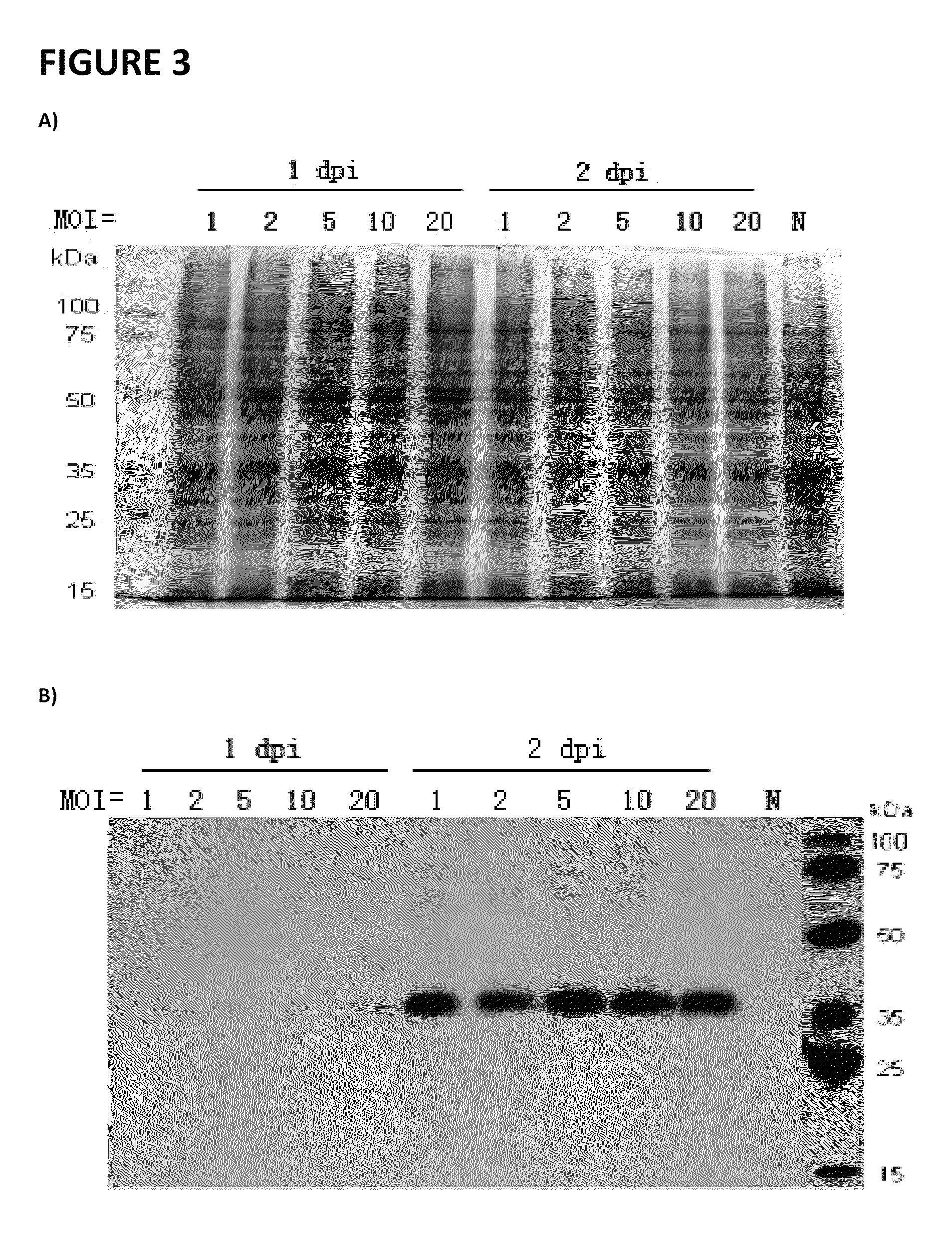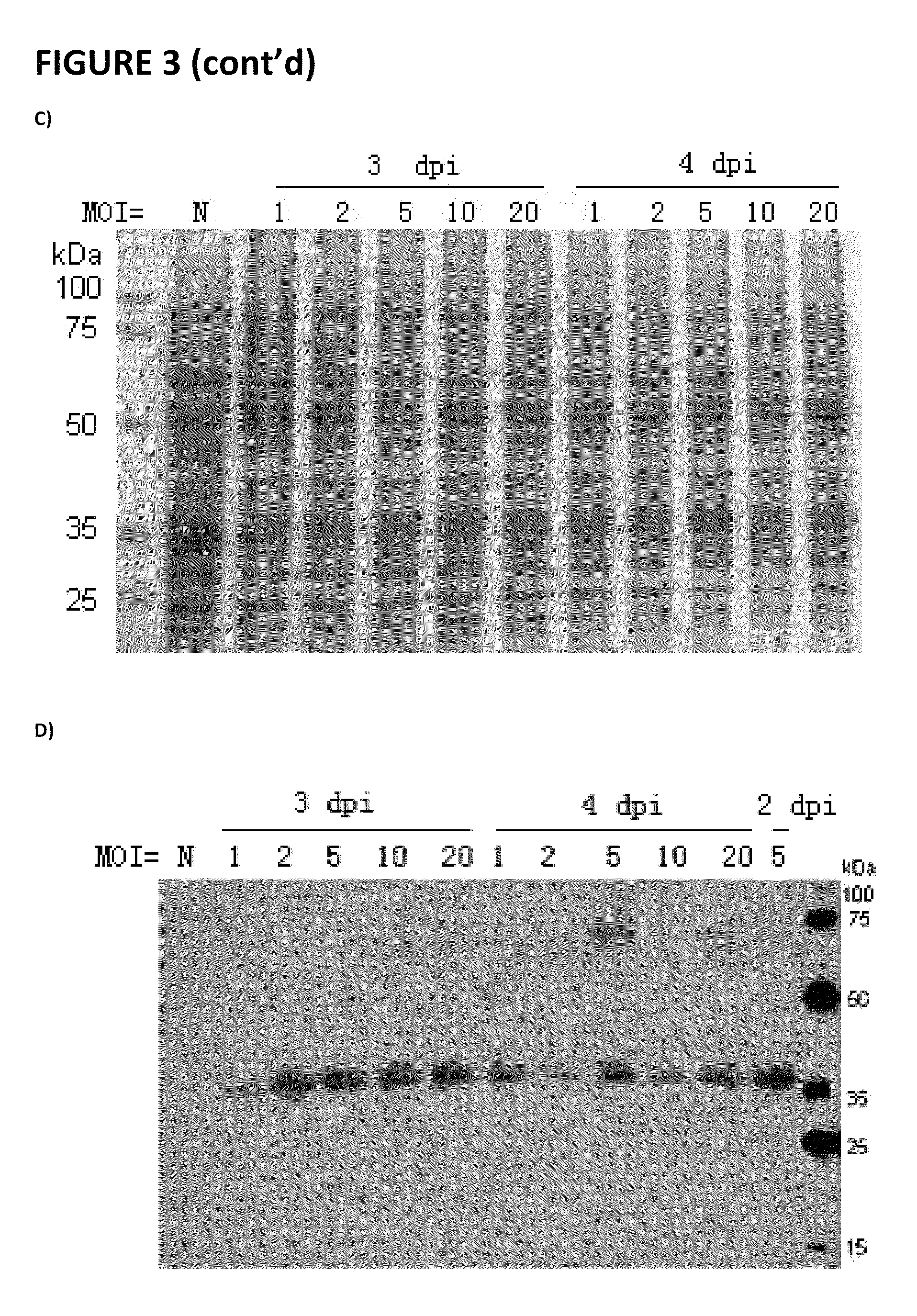Cystinosin replacement factor
a technology of cystinosin and replacement factor, which is applied in the direction of drug composition, peptide/protein ingredient, immunological disorders, etc., can solve the problems of symptomatic water and electrolyte replacement therapy, gastrointestinal and compliance problems, and social concerns
- Summary
- Abstract
- Description
- Claims
- Application Information
AI Technical Summary
Benefits of technology
Problems solved by technology
Method used
Image
Examples
example 1
Cloning and Solubility
[0072]The human cystinosin encoding gene was subcloned into pFastBacHTA vector and the resulted construct was transformed into E. coli strain DH10Bac to generate recombinant Bacmid. The gene was cloned into the pFastBacHTA vector at EcoR1 and Not 1 restriction sites (restriction sites are underlined below).
[0073]
1GAATTCATGA TCCGTAACTG GCTGACTATC TTCATCCTGT TCCCTCTGAA GCTGGTCGAG61AAGTGCGAGT CCTCCGTCAG CCTCACCGTG CCTCCCGTGG TGAAGCTGGA GAACGGTAGC121TCCACCAACG TCAGCCTCAC CCTGCGCCCC CCACTGAACG CCACCCTGGT GATCACCTTC181GAGATCACTT TCCGCTCCAA GAACATCACC ATCCTGGAGC TGCCTGACGA GGTGGTCGTG241CCTCCTGGTG TGACTAACTC TTCTTTCCAG GTGACCTCCC AGAACGTCGG ACAGCTGACC301GTGTACCTGC ACGGAAACCA CTCCAACCAG ACCGGACCCC GCATCCGCTT CCTCGTCATC361AGGTCCTCTG CTATCAGCAT CATCAACCAG GTGATCGGTT GGATCTACTT CGTGGCTTGG421AGCATCTCTT TCTACCCACA GGTCATCATG AACTGGAGGC GTAAGTCCGT GATCGGTCTG481TCCTTCGACT TCGTCGCTCT CAACCTGACC GGTTTCGTCG CTTACTCTGT GTTCAACATC541GGCCTCCTCT GGGTGCCCTA CATCAAGGAG CAGTTCCTCC TCAAG...
example 2
Replacement Therapy
[0076]Production of Cystinosin protein in a Baculoviral expression system is accomplished using GenScript, or another commercial source.
[0077]Purification of the soluble factor causing cystine depletion: the bioactive material which produces cystine depletion (SEE FIGS. 9 and 10 and Table 1) is separated by electrophoresis on 10-20% Tris-Tricine denaturing-SDS gels (Biorad; Cat #161-1162), blotted onto PVDF membranes (Biorad; Cat #162-0239), and the His epitope in the fusion-cystinosin protein is detected using an anti-His antibody, as performed by GeneScript (see attachment), as well as the anti-cystinosin mouse monoclonal antibody M09, clone 5G6 (Abnova / Novus Biologicals, Littleton, Colo.; Cat #H00001497-M09); primary antibody hybridization signals are detected using a rabbit anti-mouse HRP-conjugated secondary antibody (Chemicon International, Temecula, Calif.; Cat #AP124P) and chemiluminiscent detection (ChemiLucent™ western blot detection system; Chemicon Int...
example 3
CDF Characterization
[0083]Experiments were conducted during development of embodiments of the present invention to determine the capacity of CTNS-transfected Spodoptera conditioned medium, sialin transfected media, or putative exosomes prepared from each medium, to deplete either cystine in cystinotic cells, or sialic acid in ISSD cells after 96 h exposure.
[0084]Media was conditioned with either CTNS-transfected Spodoptera or sialin. The cells and media were either (1) dialyzed against a 3500 molecular weight cutoff membrane, and the dialysis fluid and dialysate were both collected; or (2) the media was separated into sedimentable and supernatant fractions by ultracentrifugation at 140,000×g of each medium followed by resuspension of the sedimentable fraction in Ham's F12 tissue culture medium. ISSD cells were exposed to the dialysis fluid, dialaysate, sedimentable fraction, or supernatent for 96 hours, and the cystein concentration was measured to determine the capacity of each to ...
PUM
| Property | Measurement | Unit |
|---|---|---|
| pH | aaaaa | aaaaa |
| pH | aaaaa | aaaaa |
| pH | aaaaa | aaaaa |
Abstract
Description
Claims
Application Information
 Login to View More
Login to View More - R&D
- Intellectual Property
- Life Sciences
- Materials
- Tech Scout
- Unparalleled Data Quality
- Higher Quality Content
- 60% Fewer Hallucinations
Browse by: Latest US Patents, China's latest patents, Technical Efficacy Thesaurus, Application Domain, Technology Topic, Popular Technical Reports.
© 2025 PatSnap. All rights reserved.Legal|Privacy policy|Modern Slavery Act Transparency Statement|Sitemap|About US| Contact US: help@patsnap.com



